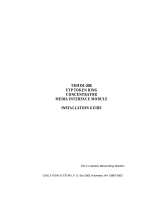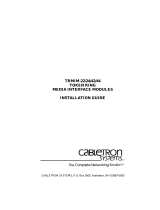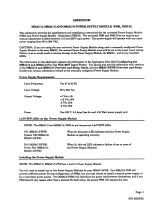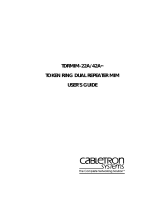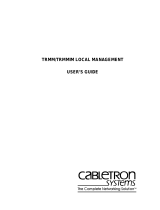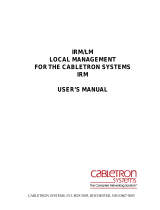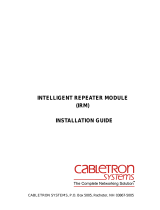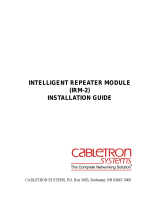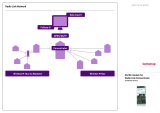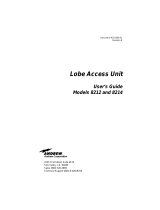Page is loading ...

TRMIM-10R
TOKEN RING
MEDIA INTERFACE MODULE
INSTALLATION GUIDE
CABLETRON SYSTEMS, P. O. Box 5005, Rochester, NH 03867-5005
The Complete Networking Solution

NOTICE
Cabletron Systems reserves the right to make changes in specifica-
tions and other information contained in this document without prior
notice. The reader should in all cases consult Cabletron Systems to
determine whether any such changes have been made.
The hardware, firmware, or software described in this manual is
subject to change without notice.
IN NO EVENT SHALL CABLETRON SYSTEMS BE LIABLE FOR
ANY INCIDENTAL, INDIRECT, SPECIAL, OR CONSEQUENTIAL
DAMAGES WHATSOEVER (INCLUDING BUT NOT LIMITED TO
LOST PROFITS) ARISING OUT OF OR RELATED TO THIS MAN-
UAL OR THE INFORMATION CONTAINED IN IT, EVEN IF
CABLETRON SYSTEMS HAS BEEN ADVISED OF, KNOWN, OR
SHOULD HAVE KNOWN, THE POSSIBILITY OF SUCH DAM-
AGES.
Copyright November 1990 by:
Cabletron Systems, Inc.
P.O. Box 5005, Rochester, NH 03867-5005
All Rights Reserved
Printed in the United States of America
Order Number: 9030258 November 90
LANVIEW, Remote LANVIEW Windows, Spectrum,
TRMIM-10R, TRRMIM-16, TRMIM-12, MMAC, and FNB are
trademarks of Cabletron Systems Inc.
IBM is a registered trademark of International Business Machines
Corporation.
NOTICE
i

FCC NOTICE
This device complies with Part 15 of FCC rules. Operation is subject
to the following two conditions: (1) this device may not cause harmful
interference, and (2) this device must accept any interference re-
ceived, including interference that may cause undesired operation.
WARNING: This equipment uses and generates and can radiate
radio frequency energy and if not installed properly and used in
accordance with the instruction manual, may cause interference to
radio communications. It has been tested and found to comply with
the limits for a Class A digital device pursuant to Part 15 of FCC
Rules, which are designed to provide reasonable protection against
such interference in a commercial environment. Operation of this
equipment in a residential area is likely to cause interference in
which case the user at his own expense will be required to take
whatever steps may be necessary to correct the interference.
If this equipment does cause interference to radio or television, which
can be determined by turning the equipment off and on, the user is
encouraged to try to correct the interference by one or more of the
following measures:
• Re-orient the receiving antenna.
• Relocate the MMAC with respect to the receiving antenna.
• Move the MMAC away from the receiver.
• Plug the MMAC into a different outlet so that the MMAC and
the receiver are on different branch circuits.
If necessary, the user should consult the dealer or an experienced
radio/television technician for additional suggestions. The user may
find the following booklet prepared by the Federal Communication
Commission helpful:
“How to Identify and Resolve Radio TV Interference Problems”
This booklet is available from the U.S. Government Printing Office,
Washington D.C. 20402 - Stock No. 004-000-00345-4
FCC NOTICE
ii

CONTENTS
CONTENTS
CHAPTER PAGE
CHAPTER 1 INTRODUCTION
1.1 Using This Manual ......................................................................1-1
1.2 The TRMIM-10R ..........................................................................1-2
1.3 Related Manuals ..........................................................................1-4
1.4 Recommended Reading................................................................1-4
1.5 Getting Help.................................................................................1-4
CHAPTER 2 INSTALLATION REQUIREMENTS/
SPECIFICATIONS
2.1 Network Requirements................................................................2-1
2.1.1 Cable Types ........................................................................2-1
2.1.2 Cable Lengths.....................................................................2-2
2.1.3 Attenuation.........................................................................2-3
2.1.4 Impedance...........................................................................2-4
2.1.5 Crosstalk.............................................................................2-4
2.1.6 Maximum Number of Stations ..........................................2-4
2.1.7 Noise ...................................................................................2-5
2.1.8 Temperature .......................................................................2-5
2.2 Operating Specifications..............................................................2-5
2.2.1 Ring Speed..........................................................................2-5
2.2.2 Connector Types .................................................................2-5
2.2.3 Ring Sequence ....................................................................2-7
2.2.4 LANVIEW LEDs ................................................................2-7
CHAPTER 3 INSTALLING THE TRMIM-10R
3.1 Unpacking the TRMIM-10R........................................................3-1
3.2 Installing the TRMIM-10R into the MMAC...............................3-1
3.3 Attaching Cables to the TRMIM-10R .........................................3-4
3.3.1 Connecting Lobe Cabling ...................................................3-4
3.3.2 Connecting Trunk Cabling ................................................3-6
3.4 Finishing the Installation............................................................3-7
iii

CONTENTS
iv
CONTENTS (Cont.)
CHAPTER 4 TESTING AND TROUBLESHOOTING
4.1 Installation Check-Out ................................................................4-1
4.2 Using LANVIEW .........................................................................4-2
APPENDIX A BASIC TOKEN RING NETWORKS
A.1 Basic Token Ring Operation .......................................................A-1
A.2 Design Considerations .................................................................A-7
APPENDIX B APPLICATIONS
B.1 Adding to an Existing Token Ring Network.............................B-1
B.2 Separate Token Ring Networks in One MMAC .......................B-2
B.3 Token Ring Networks Bridged Together ..................................B-3
B.4 MMAC with Ethernet and Token Ring Simultaneously..........B-3
APPENDIX C CALCULATING RING LENGTH
C.1 Rules for Calculating Cable Lengths ........................................C-1
C.2 Single Wiring Closet Networks .................................................C-2
C.3 Multiple Wiring Closet Networks .............................................C-9
C.4 Calculating Mixed Cable Types ...............................................C-15

INTRODUCTION
Page 1-1
CHAPTER 1
INTRODUCTION
Welcome to the TRMIM-10R Token Ring Passive Concentrator
Media Interface Module Installation Guide. This guide is
designed to serve as a reference for the installation and
troubleshooting of Cabletron Systems' TRMIM-10R.
The TRMIM-10R is a token ring network concentrator used in
conjunction with Cabletron's Multi Media Access Center (MMAC).
The TRMIM-10R provides ten trunk unit coupling ports and passive
Ring-In and Ring-Out ports. The Ring-In/Ring-Out ports and each of
the TRMIM-10R's ten trunk coupling unit ports support IBM
Types
1, 2, 6, and 9 shielded twisted pair cabling. The TRMIM-10R is IEEE
802.5 compliant, and compatible with IBM products.
Prior to installing and operating the TRMIM-10R, read through this
manual completely to familiarize yourself with its content and to gain
an understanding of the features of the TRMIM-10R. A general
working knowledge of token ring (IEEE 802.5) networks will be
helpful when installing the TRMIM-10R.
1.1 USING THIS MANUAL
Chapter 1, Introduction, covers using this document, briefly
describes features of the TRMIM-10R and token ring, and concludes
with a list of related manuals.
Chapter 2, Installation Requirements/Specifications, lists
network requirements that must be met before you install the
TRMIM-10R and specifications for the TRMIM-10R.
Chapter 3, Installing the TRMIM-10R, describes installing the
TRMIM-10R into the MMAC, attaching station cabling and
connecting the TRMIM-10R to a token ring network.
Chapter 4, Testing and Troubleshooting, includes a description of
LANVIEW, Cabletron Systems' built-in visual diagnostic and
status monitoring system and procedures for verifying the proper
installation of the TRMIM-10R.

INTRODUCTION
Page 1-2
Appendix A, Basic Token Ring Networks, covers basic operation
and concepts related to the design of token ring networks.
Appendix B, Applications, presents a variety of network
configurations, showing practical applications for several Cabletron
Systems' token ring products.
Appendix C, Calculating Ring Length, describes methods for
calculating various ring cable lengths for passive devices in a token
ring network.
1.2 THE TRMIM-10R
This section outlines some of the basic features of the TRMIM-10R.
The TRMIM-10R, shown in Figure 1-1, is a Media Interface Module
(MIM) that can be installed into a Cabletron Systems' MMAC (Multi
Media Access Center). The TRMIM-10R functions as a ten port
concentrator module in a token ring network providing passive Ring-
In and Ring-Out ports and ten trunk coupling ports.
Twelve DB-9 connectors on the front panel of the TRMIM-10R
provide one Ring-In port, one Ring-Out port for connecting the
TRMIM-10R into a token ring network and ten trunk coupling ports
for attaching ten stations.
The TRMIM-10R supports lobe lengths up to 200 meters at 4 Mbit/sec
and 100 meters at 16 Mbit/sec using IBM Type 1 or Type 2 shielded
twisted pair cable. The supported types and lengths of cables are
listed in Chapter 2, Installation Requirements/Specifications.
The Ring-In/Ring-Out ports provide passive trunk connections using
IBM Type 1 or Type 2 shielded twisted pair cable. Trunk cable
lengths must consider Adjusted Ring Length (ARL). Refer to
Appendix C, Calculating Ring Length, to determine trunk cable
length.
The Flexible Network Bus (FNB) provides an internal trunk
connection between multiple Cabletron Systems' Token Ring products
operating at the same ring speed and installed in consecutive slots
within the same MMAC. The FNB is an active interface that
regenerates and retimes ring signals between boards on the FNB.

INTRODUCTION
Page 1-3
Several LEDs are located on the front panel of the TRMIM-10R.
These LEDs indicate the ring speed, the detection of a hardware error
in the TRMIM-10R, and the status of TRMIM-10R ports. These
LEDs are a useful tool for quickly diagnosing physical layer problems.
A variety of network manangment tools can be used to control and
monitor the TRMIM-10R, including Cabletron Systems Local
Management, Cabletron Systems Remote LANVIEW Windows, and
Cabletron Systems Spectrum.
Figure 1-1. TRMIM-10R Token Ring Concentrator
TOKEN RING
TRMIM-10R
1
2
3
4
5
6
7
8
9
10
RI
RO

INTRODUCTION
Page 1-4
1.3 RELATED MANUALS
The manuals listed below should be used to supplement the
procedures and other technical data provided in this manual. The
procedures in them will be referenced, where appropriate, but will not
be repeated in this document.
Cabletron Systems' Multi-Media Access Center Overview and
Set Up Guide.
Cabletron Systems' TRMIM-12 Token Ring Media Interface
Module Installation Guide.
Cabletron Systems' TRRMIM-16 Token Ring Repeater Media
Interface Module Installation Guide.
1.4 RECOMMENDED READING
The following publications are recommended if more information is
required on implementing a Token Ring network.
Local Area Networks, Token Ring Access Method, IEEE
Standard 802.5
LAN Troubleshooting Handbook, Mark Miller (1989, M&T
Publishing, Inc.)
1.5 GETTING HELP
If you need additional support related to the Cabletron Systems'
token ring products, or if you have any questions, comments or
suggestions related to this manual, please contact Cabletron Systems'
Technical Support at:
Cabletron Systems
35 Industrial Way
P. O. Box 5005
Rochester, NH 03867-5005
Phone: (603) 332-9400

REQUIREMENTS/SPECIFICATIONS
Page 2-1
CHAPTER 2
INSTALLATION REQUIREMENTS/
SPECIFICATIONS
Before you attempt to install Cabletron Systems' token ring products,
review the installation requirements and operating specifications
outlined in this chapter. The conditions, guidelines and requirements
described in this chapter must be met to obtain satisfactory
performance from this equipment. The reliability of the network is
determined by the quality of the connections, the length of the cables
and other conditions of the installation.
2.1 NETWORK REQUIREMENTS
The following subsections summarize the network requirements to
operate this equipment.
2.1.1 Cable Types
The TRMIM-10R supports IBM shielded twisted pair cable Types 1,
2, 6, and 9 for Lobe and Trunk cabling. Table 2-1 lists all of the IBM
cable types for reference, but the TRMIM-10R supports Types 1, 2, 6,
and 9 only.
Table 2-1. IBM Cable Types
Type 1 Two shielded twisted pairs (STP) of 22 AWG solid wire
for data. Used for the longest cable runs within the
walls of buildings.
Type 2 Similar to Type 1 data cable, but having four additional
unshielded twisted pairs of 24 AWG solid wire. These
are carried outside of the shield casing and are typically
used for voice communication. Frequently used to wire
cable runs within the walls of buildings.

REQUIREMENTS/SPECIFICATIONS
Page 2-2
Table 2-1 (cont.). IBM Cable Types
Type 3 Usually four unshielded twisted pairs (UTP) of 24 AWG
solid wire for data or voice communication. Used for
cable runs in walls of buildings.
Type 5 Two 100/140 µm optical fibers in a single sheath.
Type 6 Two STP of 26 AWG stranded wire for data. This type is
used in patch panels or to connect devices to/from wall
jacks. Attenuation for Type 6 cable is 3/2 x Type 1 cable
(66 m of Type 6 = 100 meters of Type 1).
Type 8 One flat STP of 26 AWG stranded wire for under carpet
installation.
Type 9 Similar to Type 1, but uses 26 AWG solid wire.
Attenuation for Type 9 cable is 3/2 x Type 1 cable (66 m
of Type 9 = 100 meters of Type 1).
2.1.2 Cable Lengths
The TRMIM-10R is a passive concentrator. It neither regenerates
nor retimes ring signals and the cable lengths used for the TRMIM-
10R must consider the Adjusted Ring Length (ARL). ARL results
from automatic recovery processes that attempt to restore continuity
to a broken ring. The ARL is the longest potential ring length, the
ring that would exist following recovery from a failure of the shortest
ring segment trunk cable. Refer to the discussion of token ring
concepts related to ARL in Appendix A. Appendix C describes how to
calculate cable lengths in your network, giving consideration to ARL.
Considering ARL, two cable lengths must be defined for the TRMIM-
10R: Lobe Length and Trunk Length. Their combined length defines
the path between two token ring stations and cannot exceed the
maximum drive distance.
• Drive Distance - Drive distance is the limit of reliable signal
propagation without the installation of repeaters in the ring. The
maximum drive distance using STP cabling is 770 meters (2525
feet) at 4 Mbit/sec and 346 meters (1138 feet) at 16 Mbit/sec.
These limits include the combined length of all trunk cables plus
twice the length of the longest lobe cable.

REQUIREMENTS/SPECIFICATIONS
Page 2-3
• Lobe Length - This is the physical length of STP cable
connecting a station to the trunk coupling unit (TCU) port on the
TRMIM-10R. The recommended maximum length for the longest
lobe cable is shown in Table 2-2. This is a recommended
maximum because cable length calculations for passive ring
connections described in Appendix C could produce a maximum
lobe length for your network that differs from this limit.
Installing a lobe that exceeds the recommended maximum could
restrict future expansion of the network.
• Trunk Length - This is the physical length of the STP cabling in
the main ring path, from Ring-Out to Ring-In on each of the
attached token ring devices. The cable budget for the trunk
cabling must be determined by performing the calculations
described in Appendix C. In a totally passive ring (no repeaters
or active concentrators, etc. on the ring), the entire trunk length
must be included in calculation of cable lengths. When only a
portion of the ring is passive, the combined length of the trunk
cabling between the active components must be considered in the
cable length calculations.
Table 2-2. Lobe Cabling
Maximum Lobe Length
4 Mbit/sec 16 Mbit/sec
STP (IBM Types 1 & 2) 200 meters 100 meters
STP (IBM Type 6) 30 meters 30 meters
(only for station to wall
jack and patch panels)
STP (IBM Type 9) 130 meters 65 meters
2.1.3 Attenuation
Maximum attenuation for specific cable types according to ring speed,
is shown by Table 2-3. Since there are two possible ring speeds, two
frequencies are listed, namely 4.0 MHz and 16 MHz. The attenuation
values include the attenuation of the cables, connectors, and patch
panels.

REQUIREMENTS/SPECIFICATIONS
Page 2-4
Table 2-3. Maximum Cable Attenuation
4.0 MHz 16.0 MHz
STP (IBM Types 1 & 2) 22 dB/km 45 dB/km
STP (IBM Types 6 & 9) 33 dB/km 66 dB/km
2.1.4 Impedance
The characteristic impedances for specific cable types are listed in
Table 2-4. These are typical impedances, and can vary among
different manufacturers of cabling.
Table 2-4. Cable Impedance
Cable Type Characteristic Impedance
STP (IBM Types 1 & 2) 150 ohms (1 MHz to 20 MHz) ±10%
STP (IBM Types 6 & 9) 150 ohms (1 MHz to 20 MHz) ±10%
2.1.5 Crosstalk
Crosstalk is caused by signal coupling between the different cable
pairs contained within a multi-pair cable bundle. In shielded twisted
pair cables, the effects of crosstalk are minimized.
2.1.6 Maximum Number of Stations
Table 2-5 shows the maximum number of stations that can be
inserted into a single ring using STP cabling according to ring speed.
Table 2-5. Maximum Number of Stations
4 Mbit/sec 16 Mbit/sec
Number of Stations 250 stations 136 stations
NOTE: If unshielded twisted pair (UTP) cabling is used with
STP in the same ring, the number of stations is determined by
the UTP specification.

REQUIREMENTS/SPECIFICATIONS
Page 2-5
2.1.7Noise
Noise can be caused by either crosstalk or externally induced
impulses. If noise induced errors are suspected, it may be necessary
to re-route cabling away from potential noise sources (motors,
switching equipment, high amperage equipment), or to ensure that
the electrical wiring in the area is properly wired and grounded.
2.1.8 Temperature
The attenuation of PVC insulated cable varies significantly with
temperature. At temperatures greater than 40° C, we strongly
recommend that you use plenum-rated cables to ensure that cable
attenuation remains within specification. Check the cable
manufacturer's specifications.
2.2 OPERATING SPECIFICATIONS
This section includes the operating specifications for the TRMIM-10R.
Cabletron Systems Inc. reserves the right to change these
specifications at any time without notice.
2.2.1 Ring Speed
The TRMIM-10R can be operated at a ring speed of either 4 Mbit/sec
or 16 Mbit/sec. The default ring speed is set by a hardware jumper on
the TRMIM-10R. The ring speed can be changed via a software
selection (refer to the applicable Remote LANVIEW Network
Management Users Guide) that overrides the jumper selection.
2.2.2 Connector Types
• Trunk Coupling Unit Ports - Ten Female DB-9 connectors are
located on the front panel of the TRMIM-10R. They are labeled 1
through 10, corresponding to the ten Trunk Coupling Unit (TCU)
ports. Figure 2-1 shows the pin layout and signal connections for
these connectors.

REQUIREMENTS/SPECIFICATIONS
Page 2-6
FEMALE DB-9 RECEPTACLE
RX+
TX+
6
7
8
9
1
2
3
4
5
TX-
RX-
Common Ground
Common
Ground
TCU PORT
Common Ground
Not Connected
FEMALE DB-9 RECEPTACLE
TX+ (Backup Ring)
6
7
8
9
1
2
3
4
5
(Main Ring) RX-
Common
Ground
Common
Ground
(Backup Ring) TX-
FEMALE DB-9 RECEPTACLE
RX+ (Backup Ring)
6
7
8
9
1
2
3
4
5
(Main Ring) TX-
Common
Ground
Common
Ground
(Backup Ring) RX-
RX+ (Main Ring)
TX+ (Main Ring)
RING- IN RING-OUT
TCU Ports: Pin Pin Pin
1 TX– 4 Ground 7 Ground
2 Ground 5 RX– 8 Ground
3 Not Used 6 TX+ 9 RX+
Figure 2-1. TCU Ports Pinouts
• Trunk Connections - Two Female DB-9 connectors for
attaching STP trunk cables are located on the lower left side of
the TRMIM-10R front panel. Figure 2-2 show the signal and pin
assignments for the STP ring interface.
Trunk Ports: Pin Pin
Ring-In 1 RX– (Main Ring) 5 TX– (Backup Ring)
2 Ground 7 Ground
3 Ground 6 RX+ (Main Ring)
4 Ground 8 Ground
9 TX+ (Backup Ring)
Ring-Out 1 TX– (Main Ring) 5 RX– (Backup Ring)
2 Ground 7 Ground
3 Ground 6 TX+ (Main Ring)
4 Ground 8 Ground
9 RX+ (Backup Ring)
Figure 2-2. Trunk Cable Connections

REQUIREMENTS/SPECIFICATIONS
Page 2-7
2.2.3 Ring Sequence
The ring sequence on the TRMIM-10R begins at the Ring-In, goes out
to the Flexible Network Bus (FNB) then, after threading through
other attached token ring boards, returns from the FNB to sequence
through the TCU ports (in port number order) and finally out the
Ring-Out port. The following example serves to illustrate the ring
sequence in an MMAC with multiple token ring boards:
Example: TRMIM-22P in slot 1 with ports 2, 5, 8, & 12 in use.
TRMIM-10R in slot 2 with ports 1, 2, 3, 5, and 6 in use.
TRMIM-12 in slot 3 with ports 1, 5, 7, 11, & 12 in use.
All three boards are attached via the FNB.
The ring sequence in this example is from Slot 2, Ring-In port via the
FNB to Slot 3, ports 1, 5, 7, 11, 12, via the FNB to Slot 1 ports 2, 5, 8,
12; then, returning to the TRMIM-10R in Slot 2 threading through
ports 1, 2, 3, 5, and 6, then out the Ring-Out port.
2.2.4 LANVIEW LEDs
There are a number LANVIEW LEDs on the front panel of the
TRMIM-10R. The exact locations for these LEDs are illustrated in
Figure 2-3. Table 2-6 describes the functions for each LED.
Table 2-6. LANVIEW LEDs
Label Color Description
16 Mb Yellow Ring Speed Indicator
ON TRMIM-10R is set for 16 Mbit/sec
OFF TRMIM-10R is set for 4 Mbit/sec
RI/RO Green Ring-In/Ring-Out Status (2)
Status ON Respective ring port is in a non-wrap state
OFF Respective ring port is in a wrap state
ERR Red ON TRMIM-10R hardware error detected
OFF Normal operation
Link Green Link Attached (10 - One LED for each TCU port)
Attached ON The respective port is inserted into the ring.
OFF The respective port is removed (bypassed)
from the ring.

REQUIREMENTS/SPECIFICATIONS
Page 2-8
SN
16Mb
ERR
TRMIM-10R
17
LINK ATTACHED (Green) LED
(one for each trunk coupling port)
ERR (Red) LED
16Mb (Yellow) LED
TOKEN RING
5
6
RI
RO
RING-IN/RING-OUT PORT STATUS (Green) LED
Figure 2-3. TRMIM-10R LANVIEW LEDs
SAFETY
WARNING: It is the responsibility of the person who sells the
system to which the TRMIM-10R will be a part to ensure that the
total system meets allowed limits of conducted and radiated
emissions.
This equipment is designed in accordance with UL478, UL910,
NEC 725-2(b), CSA, IEC, TUV, VDE Class A, and meets FCC
part 15, Class A limits.

REQUIREMENTS/SPECIFICATIONS
Page 2-9
SERVICE
MTBF (MHBK-217E): >119,951 hrs.
MTTR: <0.5 hr.
PHYSICAL
Dimensions: 13.4D x 11.5H x 2.0W inches
(34.0D x 29.2H x 5.1W centimeters)
(includes front panel)
Weight: 2 lbs. 2 oz.
(963.9 grams)

INSTALLING THE TRMIM-10R
Page 3-1
CHAPTER 3
INSTALLING THE TRMIM-10R
This chapter contains instructions for configuring and installing the
TRMIM-10R into a MMAC and includes instructions for connecting
station and trunk cabling. Check that all requirements listed in
Chapter 2, Installation Requirements/Specifications, are met before
installing the MIM.
3.1 UNPACKING THE TRMIM-10R
Prior to installation, unpack and visually inspect the TRMIM-10R for
damage:
1. Carefully remove the TRMIM-10R from the shipping box. Save
the box and materials in the event that the unit has to be repack-
aged and shipped.
CAUTION: Electro-Static Discharges (ESD) will damage the
TRMIM-10R. Observe all precautions to prevent electrostatic
discharges and when handling the TRMIM-10R, hold only the
edges of the board or the metal front panel. Avoid touching the
components or surface of the TRMIM-10R.
2. Remove the TRMIM-10R from its protective plastic bag and set it
on top of its protective bag in a static free area.
3. Inspect the MIM for physical damage and contact Cabletron
Systems' Technical Support immediately if any problems exist.
3.2 INSTALLING THE TRMIM-10R INTO THE MMAC
The TRMIM-10R is designed to be easily installed into an MMAC
product. When you install the TRMIM-10R, the following guidelines
must be followed:
• Slot 0 of the MMAC is a reserved slot. The TRMIM-10R cannot
be installed into Slot 0.

INSTALLING THE TRMIM-10R
Page 3-2
• If the TRMIM-10R is being installed into an MMAC-8, or MMAC-
8FNB, be sure that a Power Supply Module (PSM or PSM-R) is
installed in the associated rear power supply slot. The PSM or
PSM-R is the source of power for MMAC modules. One PSM or
PSM-R is required for every two MIMs.
NOTE: The PSM-R is a Redundant Power Supply Module, that is
recommended for use with the MMAC-8FNB (equipped with a
Flexible Network Bus).
• To link several Cabletron Systems' Token Ring products that are
installed in the same MMAC, the MMAC must be configured with
a backplane and the boards must be set to the same ring speed
and in consecutive slots.
Install the TRMIM-10R as follows:
1. Position the hardware jumper on the proper pins on the TRMIM-
10R to select either 4 or 16 Mbit/sec as the default ring speed (see
Figure 3-1). The speed setting affects the number of stations and
the maximum lobe length. Refer to Chapter 2, Installation
Requirements/Specifications for additional information.
NOTE: The network speed is also selectable by software. The
software selection overrides the hardware jumper selection.
2. Power the MMAC chassis off, if it is not already powered off, by
unplugging the AC power cord from the wall outlet.
3. Remove the selected blank panel from the MMAC and slide the
TRMIM-10R (see Figure 3-2) into the MMAC card cage. Be sure
that the board is in the guides at the top and bottom of the card
cage.
4. Secure the module to the MMAC by tightening the knurled knobs.
Failure to firmly secure the MIM may result in improper opera-
tion.
5. Power the MMAC chassis on.
/
